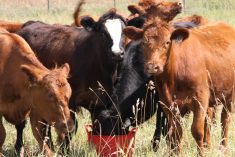A two-year delay in the United States implementation of country-of-origin labelling cast a ray of hope that the program may become voluntary.
The House of Representatives and the Senate restored funding to the mandatory labelling program embedded in the United States farm bill. However, those two arms of Congress have postponed its implementation as mandatory until Sept. 30, 2006.
“I see opposition growing all the time. I hope to see the program become voluntary,” said Neil Jahnke, president of the Canadian Cattlemen’s Association. “Voluntary labelling is not a problem for us,” he said.
Read Also

Animal protection delivery to change in Saskatchewan
The Saskatchewan government is looking for a new agency to handle animal welfare after Animal Protection Services of Saskatchewan decided not to renew its contract next year.
He said more American red meat producers cast aside their support after they examined the U.S. Department of Agriculture analysis that estimated costs of up to $3 billion to implement such a program.
The costs come due to strict record keeping requirements and separation of foreign product at the processor and retail level. The law applies to fresh meats, vegetables, peanuts and fish. Poultry is exempt.
The Montana Stockgrowers are longtime supporters of mandatory labelling but have said the delay is a good move because it provides more time to modify the law to best benefit consumers and producers.
“We question the need for such a delay in the implementation of mandatory labelling, but if that is the will of Congress, we’ll use the time to make COOL as efficient and effective as possible,” said stockgrower president John Swanz.
Suggested improvements include a better identification system to follow imports through the system and prevent foreign products from receiving a USDA grade.
The Canadian sheep industry continues to eye the law with caution.
“COOL will have an effect on us, especially for the feedlot people who ship lambs to the U.S.,” said Canadian Sheep Federation president Randy Eros. “This gives us some breathing room.”
The lamb industry has been shut out of the American market due to the border closure following a single case of bovine spongiform encephalopathy. Boneless meat is allowed into the U.S. but lamb products are generally offered bone-in, such as lamb chops or leg of lamb. Further, Canada is left with a surplus of lamb with no protection from exports.
The pork industry has examined the labelling issue and is concerned it will add costs to an industry reeling from low prices. A George Morris Centre study calculated the law could add costs of $3-$10 per hog produced in the U.S.















